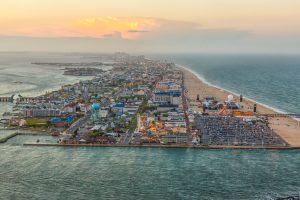
OCEAN CITY — Some of Ocean City’s chronic flooding issues could be soon relieved with an extensive project to clean the town’s vast storm drain system on tap.
The debate on the storm-drain cleaning project began last week during the Coastal Resources Legislative Committee, or Green Team, meeting and carried over to Monday’s Mayor and Council meetings. During those two sessions, it was learned the town’s drainage system had not been thoroughly cleaned since September 1985 following Hurricane Gloria.
In the three decades since, the town’s storm drains have steadily clogged to the point they are contributing somewhat to the town’s chronic flooding problem in some areas. Public Works Director Hal Adkins said this week the town’s storm drain system is vast with about 46 miles of pipe, 2,400 catch basins planted in the roadways throughout the town and 330 outfalls into the coastal bays.
“The last time we did any extensive storm drain and catch basin cleaning was in September 1985 right after Hurricane Gloria,” Adkins said. “We did it that time out of necessity. After the storm, some areas of Baltimore Avenue downtown were under two feet of sand. That’s how much sand ended up in the drainage system during that storm.”
Adkins explained how the storm drain cleanup after Hurricane Gloria worked and said a similar project has not been undertaken since.
“We brought in a fleet of jet-vac trucks and cleared what was necessary,” he said. “We didn’t clean the whole system at that time. It’s safe to say the entire system has not had a complete colonoscopy, so to speak, in over 30 years.”
Adkins said there is a potential to piggyback on a current state project to clean storm drain systems throughout Maryland with the State Highway Administration (SHA).
“We’re working with the SHA procurement office which has put out a bid package for all state-owned right-of-ways in Maryland,” he said. “They have a notice to proceed for October and we were able to get a provision added to allow Ocean City to piggyback on that contract.”
With that work expected to begin next month, Adkins said he and his staff will begin prioritizing which areas to clean first.
“I envision working with staff within that time frame to set up a prioritization for what areas we would like to do first,” he said. “I think we will incrementally start cleaning catch basins along Coastal Highway in trouble spots and start working west toward the outfalls.”
The estimated cost of cleaning the town’s entire drainage system is unknown, but Adkins said there were creative funding sources available.
“I’m not certain about the costs at this point, but it could exceed six figures,” he said. “That could be $100,000 or $200,000 and it could be done in one year or in multiple years. We won’t be sure until we start exploring the extent of it. We are fairly certain it won’t cost the town out of pocket with some of the funding that will be available.”
Some funding could come from the town’s critical area mitigation fund, which has been accumulating over the years. For example, if a developer could not meet the landscaping levels or the number of trees necessary in the critical area, payments could be made into the mitigation account that could be used by the town for the same purpose in other areas. During Monday’s Mayor and Council meeting, Mayor Rick Meehan asked if the critical areas mitigation fund was an acceptable source of funding for the project.
“This is a very important issue,” he said. “How much is in that critical area mitigation fund? This will have a cost associated with it. How about impact fees? Could they be applied in this case?”
Planning and Community Development Director Bill Neville said he would have to look into the legalities, but he believed on the surface using critical area mitigation funds would be acceptable even if the work was considered a maintenance project because of the environmental benefit.
Regardless of the funding source, which has yet to be determined specifically, cleaning the storm drain system is a top priority.
“The outcome of this will be advantageous for a variety of reasons,” said Adkins. “It should help with the flooding problems because some of those pipes are blocked considerably. There is also an environmental benefit because those drain pipes flow directly into the coastal bays. We have come across some pipes with, say, a circumference of 18 inches with half the pipe blocked. That’s an 18-inch pipe that is only opened nine inches. Some are worse than others.”

